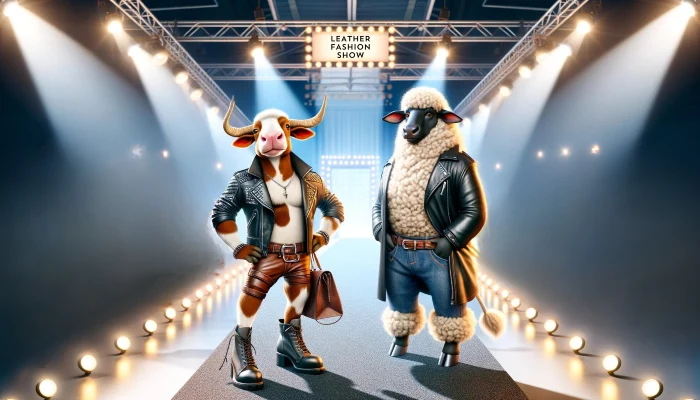When it comes to selecting the right type of leather for your needs—be it for a new leather jacket, a stylish bag, or durable furniture upholstery—the choice often boils down to cow leather or sheep leather. Each has unique characteristics that cater to different preferences and requirements. This guide dives into the world of genuine leather goods to help you decide whether cow leather or sheep leather is the better option for your next purchase, or project.
Types of Leather and Their Uses
Cow Leather
Commonly seen in the leather industry, cow leather is a popular choice for manufacturing robust items such as furniture, leather aprons, and car seats. Its durability and thickness make it an excellent choice for items that require resistance to wear and tear. The natural toughness of cowhide leather jackets and belts makes them ideal for everyday wear and heavy use.
Sheep Leather
On the other hand, sheep leather, including variants like lambskin leather and nappa leather, is celebrated for its exceptional softness and flexibility. It’s a prime material for high-end fashion items such as sheepskin leather jackets and elegant gloves. The finer grain of sheep leather also makes it a good choice for luxurious small items like wallets and bookbindings.
Physical Properties
Texture and Thickness
Cow leather generally has a thicker, more rugged texture, which contributes to its durability. It’s about twice as thick as sheep leather, making it the best option for products that need structural strength. Sheep leather, recognized for its finer grain and smooth texture, offers a more delicate and luxurious feel, ideal for fashion-forward and premium leather accessories.
Color and Appearance
Cowhide leather products often come in a variety of standard colors like black, brown, and tan, thanks to the leather’s consistent surface. Sheep leather, with its natural variations, provides a unique look that can range from ivory to deep black, appealing to those seeking a natural and subtle elegance in their leather goods.
Smell
The presence of lanolin in sheep leather gives it a distinct, albeit mild, scent that’s generally more appealing than cow leather. For those sensitive to odors, sheepskin might be the more suitable choice, as cowhide can sometimes retain a stronger, more pungent leather smell.
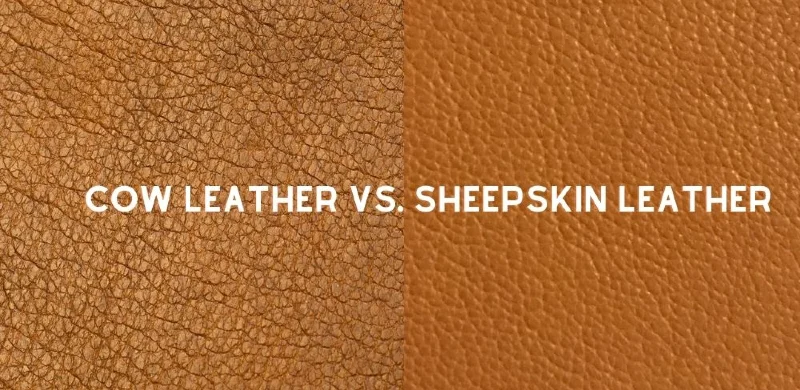
Durability and Maintenance
-
- Cow leather’s robust nature means it can handle more abrasion and stress, making it suitable for furniture that faces daily use. It is also water-resistant, which adds to its longevity.
- Sheep leather, while durable with proper care, is more prone to scratches and requires regular maintenance to maintain its appearance and texture. Sheep hide is simply not as strong as cow hide but both last a long time.
Maintenance Tips:
- Cow Leather: Use a damp cloth for cleaning and apply a high-quality conditioner to prevent drying out.
- Sheep Leather: Requires gentle cleaners and more frequent conditioning to avoid cracking.
Comfort and Flexibility
Sheep leather is undoubtedly the winner when it comes to comfort. Its lightweight and soft material make it ideal for clothing like lambskin jackets that need to offer mobility and a soft touch against the skin. Cow leather, while less pliable, offers unmatched support and structure for items like motorcycle jackets and durable footwear.
Environmental Impact of Leather Production
We’re a website dedicated to practical green guidance and sustainability so, of course, we’re going to put extra focus on the environmental impact of each option.
When evaluating the environmental consequences of any type of leather production, we must account for the full lifecycle of cow leather and sheep leather—from animal farming through to the tanning process and eventual disposal of leather goods. Both have notable environmental impacts, although the specifics differ due to variations in livestock management, tanning processes, and the scale of production. Let’s get into it!
- Resource Consumption and Emissions
- Cow Leather: Cattle farming is highly resource-intensive, demanding substantial amounts of feed, water, and land. It’s responsible for roughly 65% of the livestock sector’s greenhouse gas emissions, as cattle produce methane—a potent greenhouse gas—through enteric fermentation. Additionally, the deforestation linked to expanding pasture land for cattle, particularly in places like Brazil, contributes significantly to carbon emissions, affecting the sustainability of animal hides.
- Sheep Leather: Compared to cattle, sheep farming is less resource-demanding per animal, partly because sheep are smaller and can graze on land that’s often unsuitable for other agricultural uses. Though sheep also produce methane, their overall greenhouse gas emissions per animal are lower than cattle’s.
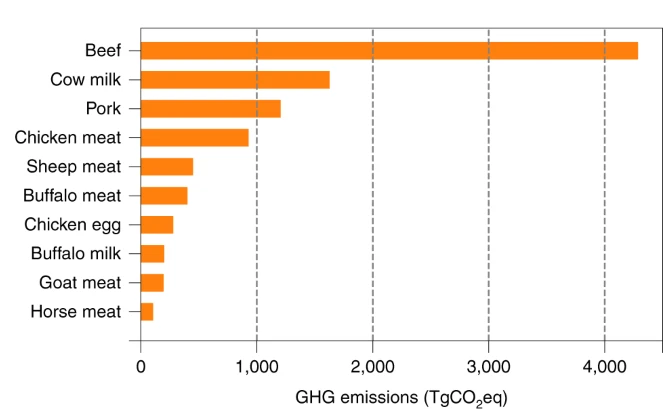
- Tanning and Chemical Use
- Chemical Exposure: Both cow leather and sheep leather undergo tanning, which typically involves heavy chemicals, including chromium. This metal can be toxic if mishandled, leading to environmental degradation if tannery effluents are improperly disposed of.
- Water Usage: The tanning process is also known for being water-intensive. It’s estimated that tanning one kilogram of hide can consume up to 50 liters of water, posing risks of water pollution that can affect both aquatic life and local communities.
- Waste and By-products
- Solid Waste: Up to 25% of the animal hide may be discarded as scraps during the leather-making process, ending up in landfills or incinerated, contributing to methane emissions and air pollution.
- Utilization of By-products: The industry attempts to improve waste management by utilizing by-products. For cow leather, scraps might be processed into gelatin, fertilizers, and animal feed, while sheep leather scraps can find uses in smaller leather goods and insulation materials, emphasizing the importance of proper care and environmental responsibility.
- Sustainability Efforts and Innovations
- Recycling and Upcycling: There’s a growing trend toward recycling and upcycling within the leather industry to minimize waste. Innovations include using composite materials from leather straps and employing reclaimed leather for new products.
- Alternative Tanning Methods: The shift towards vegetable tanning, which uses organic materials instead of heavy metals, represents a significant environmental improvement, though the process is slower.
- Comparative Analysis
- Lifecycle Analysis: A lifecycle analysis of leather goods typically shows the largest environmental impacts arise from initial livestock farming and the chemical-intensive tanning process.
- Carbon Footprint: The carbon footprint of producing leather goods is significant; however, the durability of those leather products often mean a lower overall environmental impact compared to synthetic alternatives, which require more frequent replacement (I’m thinking about companies like Boohoo, for example).
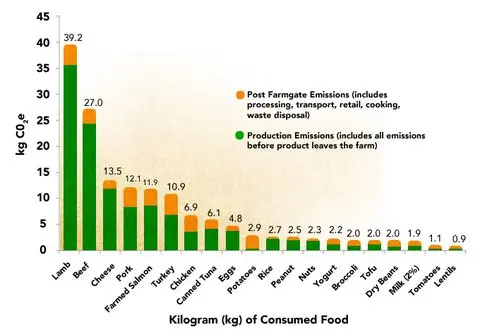
Cost Comparison
Cow leather is more affordable than sheep leather because it’s more common and is a byproduct of the beef industry. That said, the cost can vary significantly based on the quality of the hide and the craftsmanship of the finished products, as you’ll learn in the next section. In the end, you’re paying for the brand name on that bag or jacket above all else.
Fashion Trends and Consumer Preferences in Leather Goods
The leather industry is a dynamic field where both cow leather and sheep leather serve as foundational materials. Each leather type, from full-grain leather to aniline leather, offers unique aesthetic and functional qualities that appeal to various fashion sectors and consumer groups.
Aesthetic Appeal and Fashion Trends
Cow leather, celebrated for its durability and classic look, is a staple in the production of items designed for longevity and practical use. It’s the most widely used material in leather goods requiring toughness, such as motorcycle jackets and durable material footwear. Brands like Schott NYC are known for their cow hide leather jackets, which reflect a new look with each season while maintaining traditional toughness, typically priced between $600 and $1,100.
Sheep leather, particularly lamb skin, is valued for its exceptional softness and flexibility, which makes it ideal for luxury fashion. Its fine texture and light weight make it perfect for high-end sheep leather jackets and elegant accessories. Luxury brands like Chanel leverage sheep skin for their iconic handbags, such as the Chanel Classic Flap, starting at around $5,000, showcasing the natural leather as a symbol of sophistication and status.
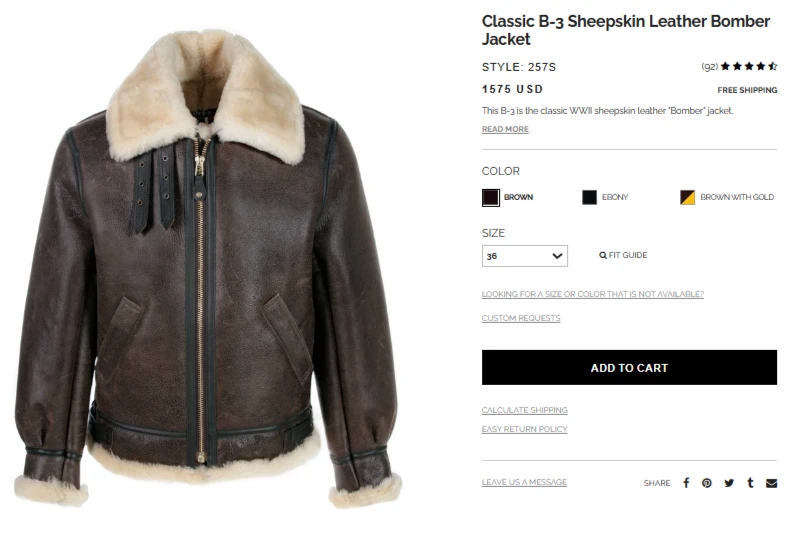
Fashion Labels Have Their Leader Preferences Too
Different types of leather are favored by distinct brands for their unique properties:
- Cow Leather: Utilitarian brands like Red Wing use genuine cowhide, known for its good resistance and water-resistant qualities, in products ranging from $200 to $400.
- Sheep Leather: Fashion giants such as Armani and Saint Laurent favor lambskin leather, known for its softness and luxurious feel, for their lines of clothing and accessories, where items typically run between $1,500 and $3,000.
Consumer Preferences
Choosing between cow and sheep leather often depends on the intended use and personal style preferences. Consumers seeking high-quality material for active use might opt for cow leather, renowned for its durability and protective properties in motorcycle jackets. Meanwhile, those desiring a more refined and stylish look might gravitate towards sheep leather, appreciated for its natural state softness and smooth texture.
Market Trends and Insights
The demand for sustainable and ethically sourced leathers is rising, particularly among younger consumers who prefer brands that focus on environmental and ethical practices. This trend is evident in the growing popularity of brands like Everlane and Reformation, which are committed to transparency and the use of natural oils and processes in their leather goods.
FAQ: Common Questions about Cow Leather and Sheep Leather
What are the key differences between cow leather and sheep leather?
Both are real leather! Cow leather is thicker, more durable, and generally used for heavy-duty products like furniture upholstery and motorcycle jackets. It’s a popular choice for items that require robustness and longevity. Sheep leather, known for its softness and finer grain, is ideal for high-end fashion items such as sheepskin jackets and luxurious leather accessories. Both offer unique properties that make them suitable for different applications in the leather industry.
Which type of leather is more environmentally friendly, cow leather or sheep leather?
It may seem like this question should have a simple answer, but it doesn’t. Actually, there are many factors at work here, including the method of production and the lifecycle of the products. Sheep leather generally has a smaller environmental footprint per animal due to sheep’s lower resource consumption. But, cow leather can be more sustainable if sourced from by-products of the meat industry and processed using advanced, eco-friendly tanning methods.
Is sheep leather more expensive than cow leather?
Yes, sheep leather is typically more expensive than cow leather. Sheepskin is softer and of finer quality, so it’s often used for premium fashion items. The production process for sheep leather also tends to be more delicate, contributing to the higher cost.
How do I maintain and care for my leather goods to ensure longevity?
Proper care of leather goods varies slightly between cow leather and sheep leather:
-
- Cow Leather: Clean with a soft, damp cloth and use a good quality leather conditioner to keep it supple. Avoid prolonged exposure to direct sunlight and harsh elements.
- Sheep Leather: Requires more delicate handling. Clean gently with a dry, soft cloth and use a leather conditioner formulated for delicate leathers. Store away from direct heat and light to prevent drying and cracking.
Can cow leather and sheep leather be used for the same products?
While both types of leather can technically be used for similar products, their unique characteristics often make them better suited for specific uses. Cow leather’s durability makes it ideal for items like leather aprons, belts, and durable shoes. Sheep leather’s softness is perfect for clothing that requires a gentle, flexible material, such as lambskin leather jackets and fashion gloves.
What should I consider when buying a new leather jacket made of either cow leather or sheep leather?
When purchasing a new leather jacket, consider the jacket’s intended use and your lifestyle. Cowhide leather jackets are great for rugged, everyday use due to their durability. On the other hand, lambskin leather jackets offer a more sophisticated, plush feel, ideal for fashion-forward wear. Also, think about the maintenance each type of leather requires and ensure you’re prepared to provide the care needed to maintain the jacket’s quality over time.
Are there any innovative uses of cow leather and sheep leather in the market?
Yes, both types of leather are being used innovatively across the fashion industry and in home decor. For instance, designers are increasingly utilizing cow leather in sustainable fashion pieces by incorporating recycled materials. Sheep leather is being explored in luxury tech accessories, providing both style and protection for high-end gadgets.
More To Discover
- 4 Healthy Homemade (and Cheap) Treats For Your Sheep or Goats [Recipes Included]
- Goats vs Cattle; Meat and Dairy Showdown & Which Is Healthier For You And The Earth
- The Myth of Vegan Leather: Real Talk on The Greenwashing and Eco-Friendliness
- Best Breeds (Cow, Goat, Pig) for Small-Scale Meat Farming: Nurturing Sustainable Agriculture and Quality Meat
Conclusion
Choosing between sheep leather and cow leather depends on several factors including intended use, desired durability, aesthetic preference, and budget. Whether you’re looking for a rugged, durable option for daily wear or a soft, luxurious material for fashion pieces, understanding these key differences will guide you to the right choice for your leather needs. Consider both the practical and aesthetic aspects when selecting your next leather product, to ensure it meets both your style and functional requirements.







